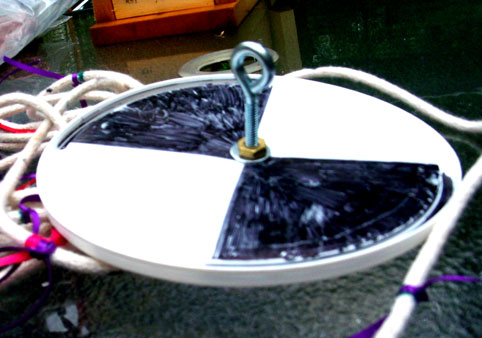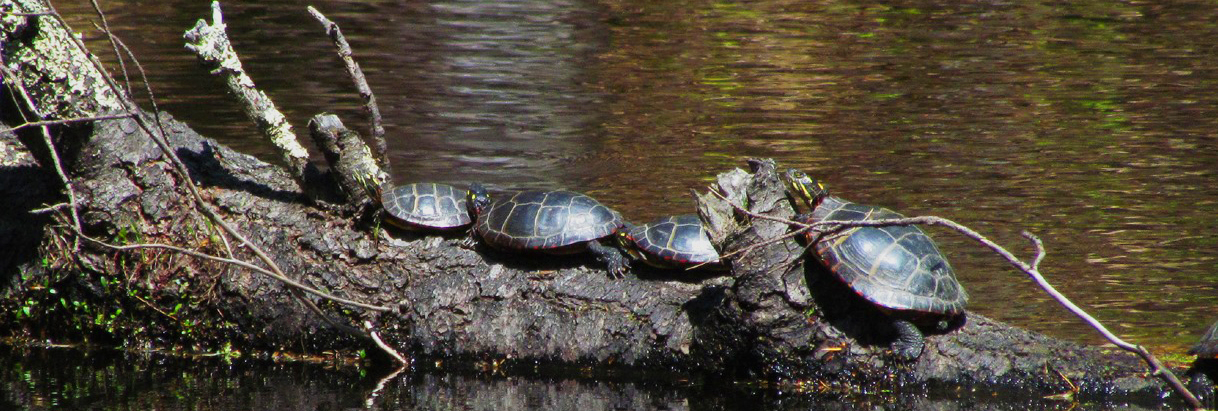TEACHER BACKGROUND-WATER TRANSPARENCY
Background:
Transparency of the water determines how far light will penetrate into the water. The more transparent the water, the deeper the microscopic plants that are the basis of the food chain can occur. Turbidity refers to the cloudiness of water and it reduces transparency. Turbidity can be caused by microscopic animals and plants, eroded soil and suspended sediments, chemicals, and even physical effects such as wind riffling the surface of the water. In this test, students will measure transparency and observe how transparency of water compares at two contrasting locations. Note: it may be difficult to do this test where the river current is fast or the depth is too shallow.
A Secchi disk (sek-ki) is a round, black and white disk that is 6 to 8 inches in diameter. It is weighted and attached to a rope that has been marked in centimeters and meters. The disk is lowered into the water until it disappears from sight. It is then slowly raised so that it is just barely visible. The depth of light penetration is determined by counting the meters and centimeters on the rope between the water’s surface and the Secchi disk as the disk is brought back to the surface. The students will make Secchi disks in class.
Preparation:
Have the items listed on the Student Experiment sheet available and build the Secchi disks as a class or team activity.
Discussion questions:
Why is transparency of the water important to plants and animals?
What might be in the water that reduces transparency?
STUDENT EXPERIMENT 5-TRANSPARENCY TESTING TEAM
Overview:
In this experiment your team will measure the transparency of the water at your river sites. The clearer the appearance of the water the more transparent it usually is, and the more light is available for water plants to use to make food. Many small animals eat these microscopic plants, called phytoplankton. The small animals are then eaten by larger animals. This is a simple food chain. Phytoplankton are the basis of many aquatic food chains that often include people.
Many things can reduce transparency and make the water turbid, or difficult to see through. Can you think of some examples? You will use a Secchi disk to measure transparency. A Secchi disk is a scientific tool for measuring the clarity or transparency of deep water.
Focus:
How far does light penetrate into the water at your chosen site?
Materials:
Pre-field experiment:
___large plastic can lid, white or light-colored, 20 centimeters (about 8 inches) in diameter
___one black waterproof marker
___10 meters of 1/4" rope (a thin clothesline rope)
___2# fishing weight
___strips of colored ribbon
___eyebolt with 2 nuts and washers
___several sharpened pencils
___data sheet and clipboards or science journals
___pencils
___meter stick
___ruler (marked with centimeters)
Field experiment:
___Secchi disk (constructed from the materials above) data sheet and clipboards or science journals
___pencils
Procedures:
Pre-field activity

1. Use your ruler to find the center of the plastic lid. Measure across the lid until you find the widest point from one side to another. Draw a line with the black waterproof marker. Then turn the lid so that the line is straight up and down. Draw a line across the widest point again. Now your lid is divided into quarters.
2. Color the upper left and lower right sections of the lid black. (You should have two black sections that are bordered by white sections.)
3. Use a sharpened pencil or a ballpoint pen to punch a hole in the middle of the lid.
4. Thread a nut and washer (in that order) onto the eyebolt.
5. With the nut and washer on the eyebolt, insert the eyebolt down through the center of the lid. Then add the other washer and nut (in that order) to the eyebolt on the underside of the lid.
6. Firmly attach the fishing weight with fishing line to the bottom of the eyebolt and bolt so that the lid will hang straight, horizontally. (This takes some trial and error experimenting.)
7. Securely tie one end of the rope through the eye of the eyebolt.
8. Using the meter stick, measure from the eyebolt 25 centimeters (about 10 inches) along the line, and tightly tie a ribbon around the line. Continue tying ribbons to the line every 25 centimeters. In the field, you'll lower the Secchi disk into the water. When you can no longer see the black and white sections, you'll stop and slowly begin to raise the Secchi disk so that you just see the white sections. At this point, you will count the number of ribbons as you continue to lift the disk out of the water.
This is a link to a site with a diagram and photo of someone using a Secchi disk. http://www.umass.edu/tei/mwwp/secchi.html
Field Experiment:
1. If possible, stand on a bridge over the water at your river location. If there is no bridge, simply use the bank. Lower the Secchi disk into the water just to the point where you can no longer see it.
2. When you can no longer see the Secchi disk, slowly lift the disk to the depth where you can just barely see it and stop. As you continue to pull the disk out of the water, count the number of ribbons as they come out of the water. When the disk comes of the water, add one more “ribbon”. The length of the rope below the surface is the distance light travels through the water and provides your transparency reading.
EXAMPLE: If you count 6 ribbons coming out, the transparency depth is 6 x 25 cm plus 25 cm, for a total of 175 cm. If you can still see the disk after it has reached the bottom, what do you think it means?
3. Repeat the procedure once or twice at different locations at your site, recording the transparency each time. To get an average of your readings, add the transparency readings and divide by the number of times you performed the test. Record the average transparency reading in your science journal.
**Note: Sometimes students cannot conduct a test of transparency, because the water is not deep enough or they could not reach the deep areas. Instead, they can observe the clarity and color of the water in the river and in pails and then record their notes on their lab sheets.
Discussion:
What do your transparency readings tell you about the water at your site? Can phytoplankton use sunlight all the way to the bottom?
If turbidity is increased, what happens to transparency?
How does light affect life in the water?
How does turbidity affect life in the water? (Hint: think about gills. If an animal “breathes” through its gills, is it easier or harder to breathe in turbid water?)

